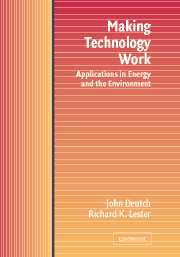Book contents
- Frontmatter
- Contents
- Preface
- 1 Introduction
- 2 Gasohol
- 3 Solar Thermal, Windpower, and Photovoltaic Technologies
- 4 Electricity from Coal
- 5 Controlling Acid Rain from Coal-fired Power Plants
- 6 Greenhouse Gases and Global Warming
- 7 Nuclear Power and Its Fuel Cycle
- 8 Managing Nuclear Waste
- 9 Nuclear Power and Weapons Proliferation
- 10 Natural Gas
- 11 Safety and Risk: Examples from the Liquefied Natural Gas and Nuclear Industries
- 12 Synthetic Fuels
- 13 Fuel Cells For Automobiles
- 14 Energy Models and Statistics
- 15 The Government's Role in Innovation
- 16 Conclusions
- Index
10 - Natural Gas
Published online by Cambridge University Press: 10 December 2009
- Frontmatter
- Contents
- Preface
- 1 Introduction
- 2 Gasohol
- 3 Solar Thermal, Windpower, and Photovoltaic Technologies
- 4 Electricity from Coal
- 5 Controlling Acid Rain from Coal-fired Power Plants
- 6 Greenhouse Gases and Global Warming
- 7 Nuclear Power and Its Fuel Cycle
- 8 Managing Nuclear Waste
- 9 Nuclear Power and Weapons Proliferation
- 10 Natural Gas
- 11 Safety and Risk: Examples from the Liquefied Natural Gas and Nuclear Industries
- 12 Synthetic Fuels
- 13 Fuel Cells For Automobiles
- 14 Energy Models and Statistics
- 15 The Government's Role in Innovation
- 16 Conclusions
- Index
Summary
Natural gas will be the world's most important source of new primary energy supplies during the next two decades. Consumption of the fuel worldwide is projected to double by the year 2020. In the United States, natural gas is currently the second most important fuel after coal, accounting for almost a quarter of all energy consumed, and the U.S. Energy Information Administration projects that domestic consumption in 2020 will be 50% higher than today. Much of this growth will occur in the electricity sector. More than 90% of additions to U.S. electricity generating capacity over the next decade will be gas-fired. Natural gas is also an attractive residential and commercial heating source (most new single-family homes use gas heating) as well as an important industrial fuel.
The emergence of natural gas as the fuel of choice for electricity generation in the United States stands in sharp contrast to the situation less than two decades ago. After vigorous growth earlier in the twentieth century, U.S. gas consumption peaked in the early 1970s and continued to decline until the middle part of the 1980s (see Figure 10.1). During part of this period, the use of natural gas by electric utilities was actually prohibited by the federal government on the grounds that it should not be “wasted” by combustion in utility boilers but rather conserved for more important uses such as heating homes and as feedstock for chemical plants. In this chapter, we will examine the reasons for this striking reversal.
- Type
- Chapter
- Information
- Making Technology WorkApplications in Energy and the Environment, pp. 164 - 180Publisher: Cambridge University PressPrint publication year: 2003

